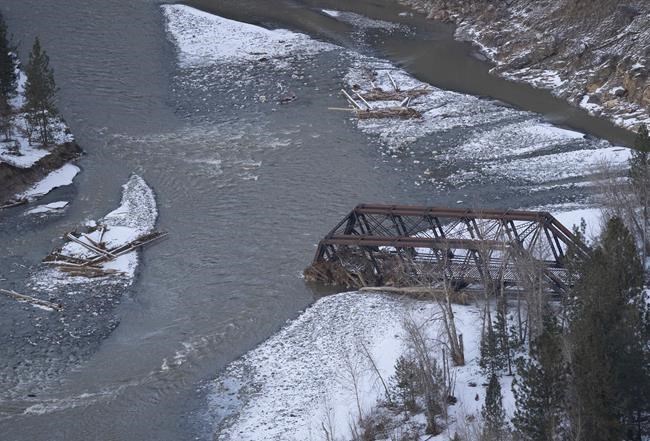VICTORIA — Economic growth in British Columbia will face erosion from recent floods and slides that crippled transportation links, but the resilience of government and industry to keep supply chains open limits the damage, says an economist.
Vital road, rail and port links were severed for weeks when a series of record-breaking rains last month deluged southern B.C., flooding highways and farms and forcing about 15,000 people to evacuate their homes.
Ken Peacock, senior vice-president and chief economist at the Business Council of B.C., said he estimated the weather disaster will result in lost economic output for the province ranging from $250 million to $400 million.
"We're sort of thinking maybe the direct impact of shutting down the highways, closing the rails, the Trans Mountain pipeline being down and then the retail impacts, we're kind of thinking maybe three-tenths of a percentage point," he said.
"It would shave off growth for 2021."
He said the economic impact estimate does not forecast the repair and rebuilding costs, which the government has said will be massive.
Finance Minister Selina Robinson said recently she will provide a cleared picture of the province's finances in her February budget. Last month she said B.C. was heading for a strong economic recovery after a 3.4 per cent decline in 2020, but uncertainties due to the COVID-19 pandemic and the flood damage costs remain.
Earlier this month, Robinson said the province's Economic Forecast Council predicted economic growth in B.C. of 5.3 per cent in 2021 and 4.2 per cent in 2022.
Peacock said the economic impact of the floods would have been felt more if the province was not in a period of economic rebound.
"So three-tenths of a percentage point doesn't feel or sound like much when you are talking four per cent growth. But if we're in our normal world of two per cent to two-and-a-half per cent growth, then three-tenths of a per cent is much more meaningful," he said.
The closure of highways and rail lines due to flooding and limited access to port facilities in Vancouver sent alarms to government and industry to quickly repair infrastructure and keep supply chains in operation, even if it meant moving goods on different highways or rail routes, said Peacock.
"One thing that has become very clear for sure for government and policy-makers is that this has been kind of not a warning but a very clear indicator of just how dependent we are on some infrastructure and transportation connections," he said.
The four-lane Coquihalla Highway, the major road transportation route to and from Vancouver, reopened to commercial traffic Dec. 20 after floods and slides damaged 20 sections of the highway, including seven bridges.
Officials at Vancouver's port, the largest in Canada, said rail service is flowing smoothly again following major disruptions due to damaged rail lines.
"While the reopening of the Coquihalla Highway will provide renewed access for the movement of goods by truck throughout the Interior of B.C. and into Alberta, the majority of volumes across all sectors moving to and from the port move by rail," said Vancouver Fraser Port Authority in a statement. "At this time, both railways serving the port are currently operating consistently between Vancouver and Kamloops."
James Thompson, vice-president of western operations for Canadian National Railway, said access to the Vancouver port was cut off from Nov. 14 to Dec. 4 due to 58 damaged sites in the Fraser Canyon area from Ashcroft to Yale.
It took 400 employees and 110 pieces of equipment working 24 hours a day, seven days a week to repair the tracks, with the largest job being a major washout in the Fraser Canyon at Jackass Mountain, he said.
"We put 282,000 yards of rock to backfill what was taken away in the slide and storm, and to put that in approximate terms that are easy to understand, that's approximately 25,000 18-wheeler loads of ballast rock, riprap and other materials at that one location," said Thompson.
CN was effectively shut down from Kamloops to Vancouver, forcing the company to move some of its traffic to Prince Rupert, he said.
Thompson said the storm was a one of a kind event. But coming just months after wildfires in the same area that closed rail service, it only served as a reminder of the power of weather in the era of climate change.
"We do try and plan and build contingencies and resiliency into our network. But at the end of the day, I can't say it any better than this: the railroad is an outdoor sport and Mother Nature makes the rules," he said.
This report by The Canadian Press was first published Dec. 26, 2021.
Companies in this story: (TSX:CNR)
Dirk Meissner, The Canadian Press




